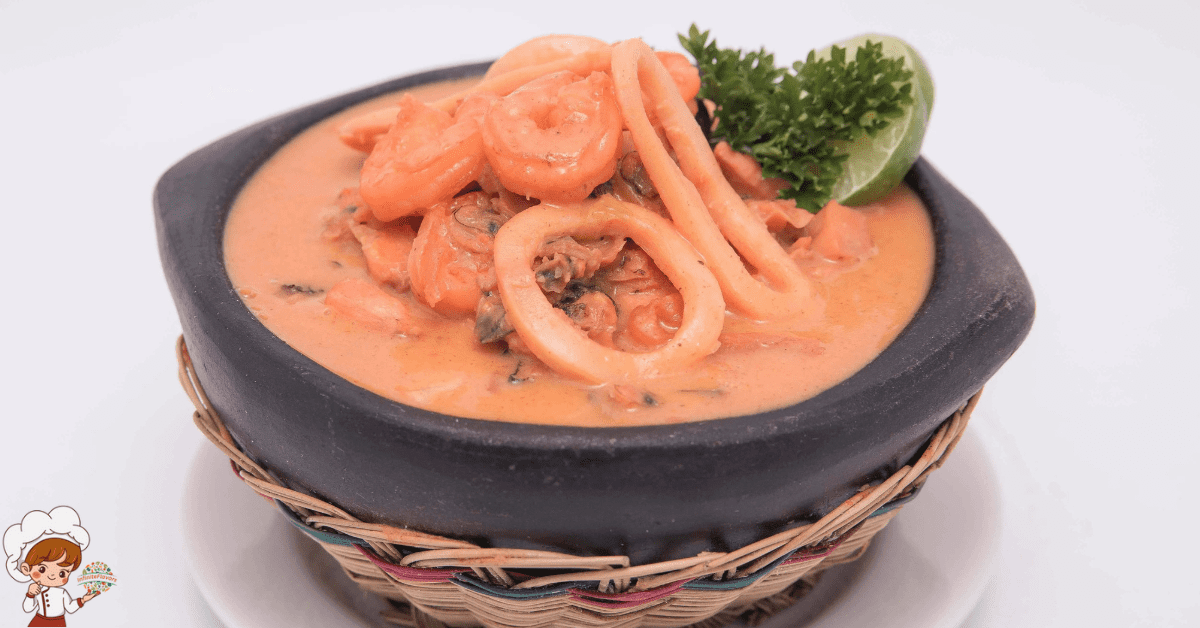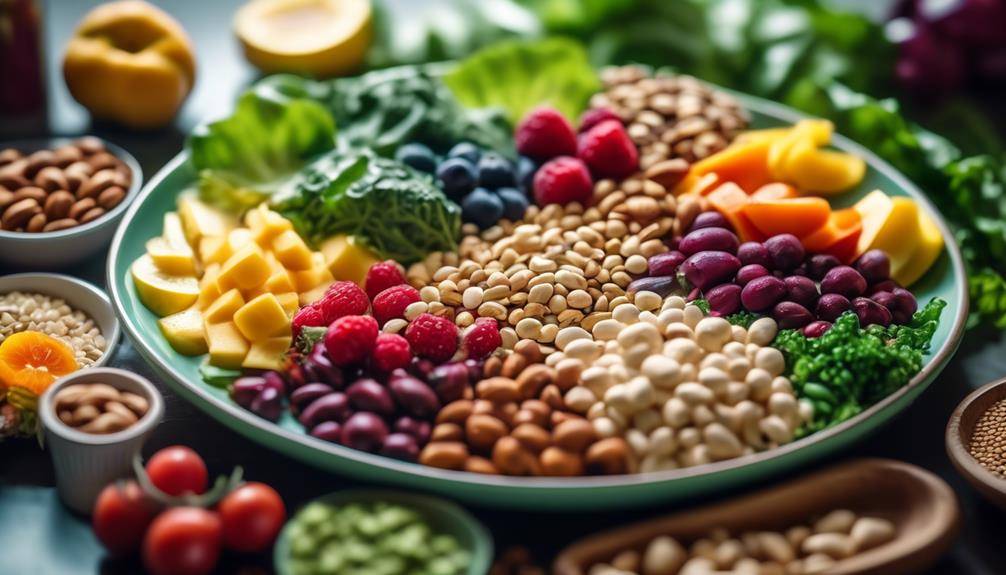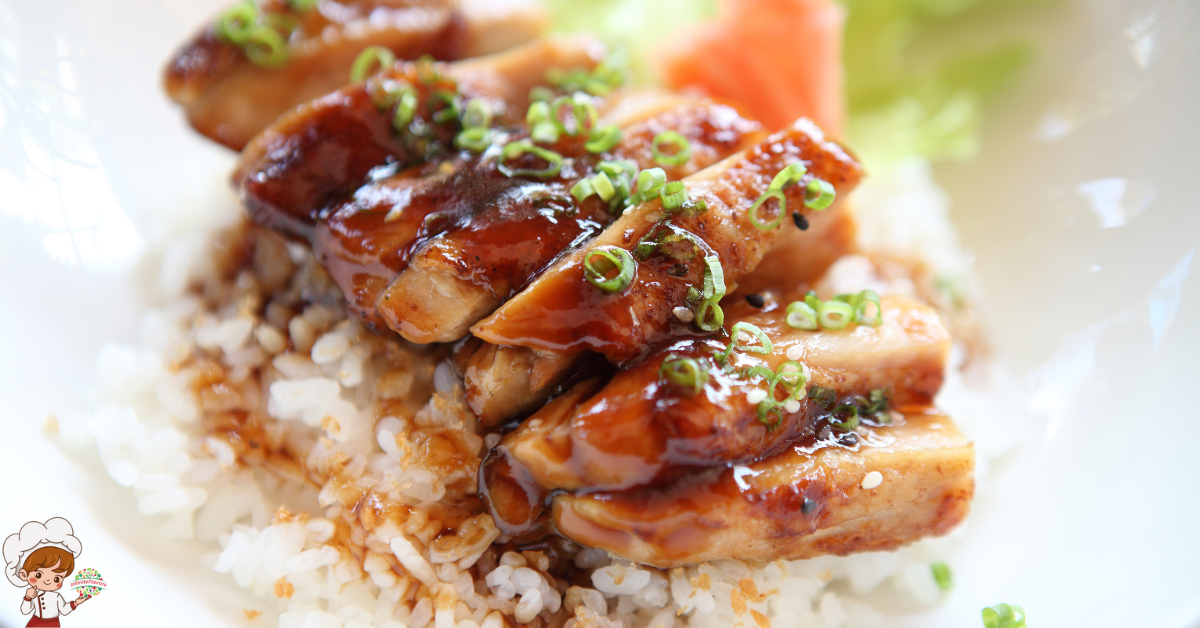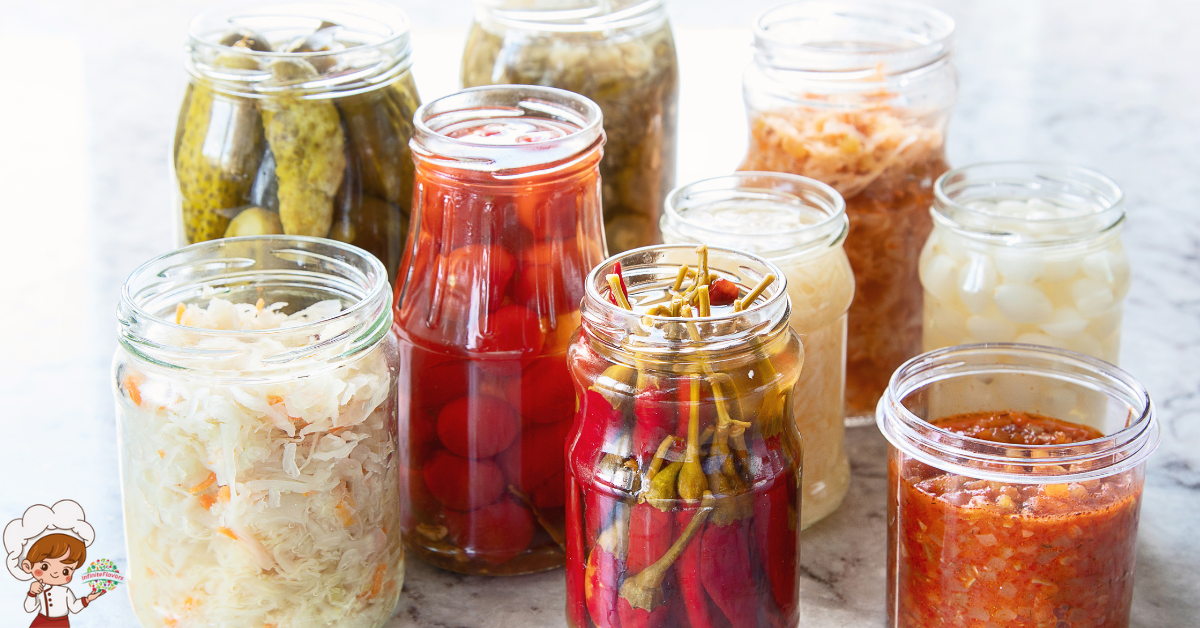Four-Step Guide To The Perfect Seafood Bisque Preparation

Perfect Seafood Bisque; Are you tired of spending hours in the kitchen, only to end up with a lackluster seafood bisque? Imagine this: you invite your friends over for a dinner party, hoping to impress them with your culinary skills. As you serve the first spoonful of your seafood bisque, you notice their disappointed expressions. But fear not, because in this four-step guide, we will walk you through the process of achieving the perfect seafood bisque. From selecting the freshest seafood to garnishing for the wow factor, get ready to elevate your bisque game to new heights. So, let’s dive in and uncover the secrets to creating a seafood bisque that will leave your guests begging for more.
Selecting the Freshest Seafood
To ensure the highest quality and flavor in your seafood bisque, it is essential to carefully select the freshest seafood available. When it comes to seafood sourcing, there are a few tips that can help you make the best choices for your bisque. First and foremost, always buy seafood from a reputable source. Look for a fishmonger or seafood market that is known for their high-quality products and takes pride in their sourcing practices. Fresh seafood should have a clean, briny smell, and the flesh should be firm and shiny, not slimy or dull.
When selecting specific types of seafood for your bisque, consider the cooking techniques that will be used. For example, if you plan to incorporate shrimp or crab into your bisque, opt for shell-on varieties. The shells not only add flavor to the broth but also protect the delicate meat during cooking, ensuring it stays tender and juicy. Additionally, when choosing fish for your bisque, go for varieties that are robust and meaty, such as salmon or halibut. These types of fish can stand up to the rich flavors of the bisque and won’t break apart easily during cooking.
In terms of sustainability, it’s important to be mindful of the seafood choices you make. Look for seafood that is labeled as sustainable or caught using methods that have minimal impact on the environment. This can help to ensure that you are making responsible choices that support the long-term health of our oceans.
Preparing the Flavorful Base
Now that you have carefully selected the freshest seafood for your bisque, it’s time to dive into preparing the flavorful base. The key to a truly delicious seafood bisque lies in the rich and flavorful base that enhances the natural taste of the seafood. There are several techniques you can employ to achieve this depth of flavor and to ensure that every spoonful of your bisque is a delight to the senses.
Firstly, start by sautéing aromatic vegetables such as onions, celery, and carrots in a little butter or olive oil. This step adds a savory undertone to the base and provides a solid foundation for the seafood flavors to shine through. Allow the vegetables to soften and release their natural sweetness before moving on to the next step.
Next, it’s time to introduce the star of the show – the seafood. Add your chosen seafood, whether it be shrimp, lobster, or a combination of different types, to the pot. Sauté the seafood briefly to lightly cook it and release its flavors. Be careful not to overcook the seafood at this stage, as it will continue to cook as the bisque simmers.
To further enhance the seafood flavor, deglaze the pot with a touch of white wine, scraping up any browned bits from the bottom. This step not only adds depth to the base, but it also helps to tenderize the seafood and infuse it with the delicate flavors of the wine.
Sauteing the Aromatics
Begin by heating a small amount of butter or olive oil in a pot, allowing it to melt and coat the bottom with its rich, savory aroma. Sauteing the aromatics is a crucial step in creating the perfect seafood bisque. This process involves cooking the vegetables and spices until they release their flavors, resulting in a robust and aromatic base for your bisque. Here are three sauteing techniques to enhance the flavor infusion in your bisque:
- Sizzle the onions: Add finely chopped onions to the pot and saute them until they turn translucent and start to caramelize. This will bring out their natural sweetness and add a depth of flavor to your bisque.
- Mingle with garlic: Crushed garlic cloves can be added to the sauteed onions. Allow them to cook for a minute or two until they become fragrant. The combination of onions and garlic will create a harmonious flavor profile, enhancing the overall taste of the bisque.
- Spice it up: To further elevate the flavor, incorporate spices like thyme, bay leaves, or paprika into the sauteed mixture. The heat from the sauteing process will awaken the spices, releasing their aromatic oils and infusing the bisque with delightful flavors.
Adding the Perfect Seasonings
Now that you’ve sautéed the aromatics, it’s time to add the perfect seasonings to elevate the flavors of your seafood bisque. The spice selection is crucial in creating a well-balanced and flavorful dish. Whether you opt for classic herbs like thyme and bay leaf or prefer a touch of heat with cayenne pepper, choose seasonings that complement the delicate flavors of the seafood. Experiment with different seasoning techniques, such as adding them at different stages of cooking or using a combination of dry spices and fresh herbs, to achieve the perfect taste profile for your bisque.
Spice Selection
To enhance the flavor profile of your seafood bisque, carefully select the perfect combination of spices and seasonings. Spice pairing is crucial in achieving a harmonious blend of flavors that will elevate your bisque to new heights. Here are three essential spices to consider for flavor enhancement:
- Paprika: This vibrant spice adds a subtle smokiness and a touch of sweetness to your bisque. Choose a high-quality Spanish paprika for a deeper and more complex flavor.
- Cayenne Pepper: Add a kick of heat with a dash of cayenne pepper. It balances the richness of the bisque and adds a delightful spicy note that lingers on the palate.
- Thyme: This aromatic herb brings a hint of earthiness and a refreshing, herbaceous flavor to your seafood bisque. Its delicate notes complement the seafood perfectly, enhancing its natural taste.
Seasoning Techniques
Enhance the flavor profile of your seafood bisque by mastering the art of seasoning techniques. Seasoning secrets hold the key to unlocking the full potential of your dish, elevating it from good to outstanding. When it comes to enhancing flavors, precision is essential. Start by adding a pinch of salt to bring out the natural sweetness of the seafood.
Next, a dash of freshly ground black pepper adds a subtle heat that complements the richness of the bisque. To enhance the depth of flavor, a sprinkle of dried thyme or a bay leaf can work wonders. Finally, a squeeze of lemon juice brightens the overall taste, adding a refreshing zing. By carefully balancing these seasonings, you can create a seafood bisque that is bursting with deliciousness.
Incorporating the Seafood
To elevate your seafood bisque to new heights, infuse the flavors of the ocean delicacies into the velvety broth. Incorporating the seafood is a crucial step that requires careful consideration to ensure the perfect balance of flavors and textures. Here are three essential tips to help you achieve seafood bisque perfection:
- Seafood Presentation:
When incorporating seafood into your bisque, it’s important to pay attention to the presentation. Cut the seafood into bite-sized pieces that are visually appealing and easy to eat. Whether you’re using succulent shrimp, tender lobster, or delicate scallops, make sure each piece is showcased beautifully in the bisque. This not only enhances the aesthetic appeal of the dish but also allows you to savor the seafood’s texture and flavor with each spoonful.
- Alternative Seafood Options:
While traditional seafood bisque often features lobster or shrimp, don’t be afraid to explore alternative seafood options. Consider adding chunks of flaky white fish, such as cod or halibut, for a delightful twist. You can also experiment with different shellfish like mussels or clams to add depth and complexity to the bisque. The key is to choose seafood that complements the base flavors of the bisque while adding its own unique touch.
- Timing is Key:
When incorporating seafood into the bisque, timing is crucial. Seafood tends to cook quickly, and overcooking can lead to a rubbery texture and loss of flavor. Add the seafood towards the end of the cooking process, just enough time for it to cook through without becoming tough. This ensures that the seafood retains its natural tenderness and enhances the overall taste and texture of the bisque.
Simmering to Perfection
Now that you’ve incorporated the seafood into your bisque, it’s time to simmer it to perfection. The cooking time for the bisque is crucial, as it allows the flavors to meld together and develop. Additionally, choosing the right combination of flavorful ingredients will enhance the taste and depth of your bisque.
Cooking Time for Bisque
For the perfect bisque, simmering is the key to achieving a rich and flavorful seafood broth. Simmering allows the flavors of the ingredients to meld together, resulting in a delicious and aromatic bisque. To ensure that your bisque is cooked to perfection, follow these three cooking time tips:
- Simmer the bisque for at least 30 minutes: This will allow the flavors to develop and intensify, creating a more robust and complex taste.
- Avoid boiling the bisque: Boiling can cause the seafood to become tough and rubbery. Keep the heat low and maintain a gentle simmer for the best results.
- Taste and adjust as needed: Throughout the cooking process, taste the bisque and adjust the seasonings accordingly. This will ensure that the flavors are balanced and harmonious.
Flavorful Ingredient Combinations
Enhance the depth and complexity of your seafood bisque by carefully selecting flavorful ingredient combinations that will simmer to perfection. When it comes to flavor pairing tips for seafood bisque, there are a few key elements to consider. First, choose a variety of seafood such as shrimp, lobster, or scallops to add different layers of taste. Each type of seafood brings its unique flavors, textures, and aromas to the bisque.
Secondly, incorporate aromatic vegetables like onions, garlic, and celery to add depth and enhance umami. These ingredients provide a savory undertone to the bisque, creating a rich and satisfying flavor. Lastly, don’t forget the herbs and spices. Fresh herbs like thyme, parsley, and bay leaves add freshness, while spices like paprika and cayenne pepper bring a hint of heat and complexity. By combining these flavorful ingredients, your seafood bisque will simmer to perfection, delighting your taste buds with its rich and complex flavors.
Creating a Smooth and Creamy Texture
To achieve a velvety smooth and lusciously creamy texture in your seafood bisque, incorporate a combination of indulgent ingredients and expert techniques. Here are three key tips to help you create the perfect consistency:
- Start with a roux: A roux is a mixture of equal parts fat and flour used to thicken sauces and soups. To create a smooth texture in your bisque, begin by making a roux with butter and flour. This will help to bind the ingredients together and give the soup a creamy base.
- Use heavy cream: Heavy cream is a staple ingredient when it comes to achieving a rich and creamy texture. Add it gradually to your bisque, stirring constantly, until you reach the desired consistency. Be careful not to overheat the cream, as it may curdle and ruin the smoothness of the soup.
- Blend and strain: To ensure a silky smooth bisque, use an immersion blender or a regular blender to puree the ingredients until they are completely smooth. This will help to break down any large chunks and create a consistent texture throughout the soup. After blending, pass the bisque through a fine mesh strainer to remove any remaining solids and achieve a velvety finish.
Balancing the Flavors
Achieving a well-balanced flavor profile is essential in creating a truly delightful seafood bisque. To ensure that every spoonful of your bisque is bursting with flavor, it is important to use flavor balancing techniques and enhance the umami flavors.
One technique to balance the flavors in your seafood bisque is to incorporate a variety of ingredients that complement each other. For example, the sweetness of fresh seafood can be balanced with the acidity of tomatoes or a squeeze of lemon juice. Additionally, the richness of cream can be balanced with the subtle bitterness of herbs like thyme or the earthiness of mushrooms.
Another way to enhance the flavors in your bisque is to focus on umami. Umami is the fifth basic taste, often described as savory or meaty. To intensify the umami flavors in your bisque, you can use ingredients such as anchovies, soy sauce, or Parmesan cheese. These ingredients add depth and complexity to the overall flavor profile of the bisque.
Furthermore, don’t forget the importance of seasoning. Salt and pepper are essential for bringing out the flavors in your bisque. Taste as you go and adjust the seasoning accordingly. Remember that the flavors will continue to develop as the bisque simmers, so it’s important to add seasoning gradually and taste frequently.
Perfecting the Bisque’s Thickness
To perfect the thickness of your seafood bisque, you need to master consistency control techniques and choose the right thickening agents and methods. Consistency control techniques involve adjusting the amount of liquid and simmering time to achieve the desired thickness. Thickening agents like flour, cornstarch, or roux can be used to thicken the bisque, while methods like blending or straining can also contribute to the desired texture. By understanding these points, you’ll be able to create a seafood bisque with the perfect thickness every time.
Consistency Control Techniques
You can achieve the perfect thickness for your seafood bisque by implementing effective consistency control techniques. Maintaining the right consistency is crucial to ensure a delightful dining experience. Here are three techniques to help you achieve the desired thickness:
- Reduce and Simmer: Start by cooking your bisque over low heat, allowing it to reduce gradually. This process concentrates the flavors while thickening the soup naturally.
- Roux or Cornstarch Slurry: If your bisque needs a quick thickening boost, you can create a roux or cornstarch slurry. Mix equal parts flour or cornstarch with butter to make a roux, or dissolve cornstarch in cold water to create a slurry. Gradually add the mixture to your bisque while stirring continuously until you reach the desired thickness.
- Puree and Strain: For a smooth and velvety bisque, blend a portion of the soup until smooth, then pass it through a fine-mesh strainer. This technique helps eliminate any lumps or chunks while adding body to the bisque.
Thickening Agents and Methods
As we continue our exploration of perfecting the bisque’s thickness, let’s now turn our attention to the various thickening agents and methods that can be employed. When it comes to thickening agents, there are both traditional and modern options to consider. Traditional agents include flour and butter roux, which provide a rich and velvety texture to the bisque. On the other hand, modern thickening agents such as cornstarch and arrowroot offer a lighter and smoother consistency.
It’s important to note that each thickening agent has its own unique properties, so it’s worth experimenting to find the perfect one for your desired outcome. As for the methods, the traditional stovetop simmering technique allows the flavors to meld together while the modern immersion blender method ensures a smooth and creamy bisque. By comparing these thickening agents and methods, you can achieve the perfect thickness for your seafood bisque.
Garnishing for the Wow Factor
Enhance the visual appeal of your seafood bisque with an artful and enticing garnish. A well-executed garnish can elevate the overall presentation of your dish, making it more visually appealing and enticing to your guests. Here are three ideas to help you achieve that wow factor:
- Herb Sprinkle: Sprinkle a mixture of finely chopped fresh herbs, such as parsley, chives, and dill, over the top of your seafood bisque just before serving. The vibrant green colors and aromatic fragrance of the herbs will add a pop of freshness to the dish, making it visually appealing and appetizing.
- Seafood Alternatives: Consider adding some additional seafood elements to your garnish to create a more dynamic and eye-catching presentation. Thinly sliced seared scallops or shrimp can be placed on top of the bisque, adding both texture and visual interest. This not only enhances the overall appearance but also introduces more seafood flavors to complement the bisque.
- Citrus Zest: Sprinkle some finely grated lemon or orange zest on top of your seafood bisque. The bright citrus flavors and vibrant colors will not only add a burst of freshness but also create a visually striking contrast against the creamy bisque. This simple yet effective garnish can make your dish look more enticing and sophisticated.
Pairing With the Right Bread or Crackers
To enhance the overall dining experience, carefully select the perfect bread or crackers to pair with your seafood bisque. Choosing the right accompaniment can elevate the flavors of the bisque and add a delightful texture to each bite. When deciding between bread and crackers, consider the flavor pairings that will complement the rich and creamy nature of the bisque.
If you prefer bread, opt for a crusty baguette or a sourdough loaf. The crisp exterior and chewy interior of a baguette provide a satisfying contrast to the smoothness of the bisque. Spread a layer of butter or herb-infused olive oil on the slices for an additional burst of flavor. Sourdough, with its tangy taste, adds a subtle acidity that cuts through the richness of the bisque, creating a harmonious balance.
On the other hand, crackers offer a convenient and portable option for enjoying seafood bisque. Consider choosing crackers with a delicate flavor, like water crackers or oyster crackers. These plain and lightly salted crackers allow the bisque to take center stage, without overpowering its delicate flavors. For a more adventurous pairing, try using flavored crackers like garlic or herb-infused varieties. The added herbs and spices can enhance the overall experience by providing an extra layer of complexity to each spoonful.
Ultimately, the choice between bread and crackers depends on personal preference and the desired dining experience. Both options offer their unique contributions to the flavor profile of the bisque. So, whether you prefer the rustic charm of crusty bread or the convenience of crackers, make sure to choose an accompaniment that enhances and complements the rich and indulgent seafood bisque.
Storing and Reheating Tips
For optimal freshness and taste, follow these simple guidelines when storing and reheating your delectable seafood bisque.
- Storing Tips
- First, allow your bisque to cool completely before storing it. This will prevent condensation from forming and affecting the texture and flavor.
- Transfer the bisque to an airtight container before placing it in the refrigerator. Ensure that the container is clean and free from any strong odors that could be absorbed by the bisque.
- To further extend its shelf life, you can also freeze the seafood bisque. Divide it into individual portions and store them in freezer-safe containers or bags. Remember to label each container with the date for easy reference.
- Reheating Techniques
- When reheating the bisque, it is best to do so on the stovetop. This will allow for more even heating and better control over the temperature.
- Place the desired amount of bisque in a saucepan and heat it over low to medium heat. Stir occasionally to prevent scorching.
- Avoid boiling the bisque as this can cause the seafood to become rubbery. Heat it just until it is hot throughout, stirring gently.
Impressing Your Guests With Plating Techniques
Impress your guests with the artful presentation of your seafood bisque by utilizing elegant plating techniques. The way you present your dish can elevate the dining experience and make it even more memorable. Plating techniques play a vital role in creating a visually appealing and appetizing seafood bisque presentation.
Start by selecting the right plate. Choose a large, shallow bowl or plate that complements the colors and textures of your seafood bisque. A white plate often works well, as it provides a clean canvas to showcase the vibrant colors of the bisque and the garnishes.
Next, consider the placement of your elements. Pour the bisque into the center of the plate, creating a smooth and even base. Place the main seafood ingredients, such as succulent shrimp or tender scallops, strategically around the bowl. This will add visual interest and highlight the star ingredients of your dish.
Garnishes are an excellent way to add texture and flavor to your seafood bisque presentation. Sprinkle a pinch of chopped fresh herbs, such as parsley or chives, on top of the bisque. Alternatively, you can create a beautiful swirl or pattern with a drizzle of cream or a few drops of vibrant herb oil.
Remember to consider the overall composition of the plate. Balance is key. Pay attention to the arrangement of the elements, ensuring that they are evenly distributed and visually appealing. Consider the concept of negative space to create a sense of elegance and sophistication.
Perfect Seafood Bisque; Frequently Asked Questions
Can Seafood Bisque Be Made With Frozen Seafood?
Using frozen seafood in seafood bisque has its pros and cons. While fresh seafood may offer better flavor, frozen seafood can still be used with some tips. Enhance the flavor by adding herbs, spices, and a splash of wine.
Is It Necessary to Strain the Bisque Before Serving?
Before serving the bisque, it is necessary to strain it. This ensures a smooth and velvety texture, removing any unwanted chunks or shells. The pros of using a roux in bisque preparation include thickening the soup, while the cons may be a heavier flavor. Different types of seafood, such as lobster, shrimp, or crab, work best in bisque recipes, adding depth and richness to the dish.
How Long Should I Simmer the Bisque For?
To achieve the perfect thickness for your seafood bisque, simmer it for about 30 minutes. This will allow the flavors to meld together and the soup to thicken. Don’t forget to add the best spices to enhance the flavor!
Can I Substitute Dairy Products for the Cream in the Bisque?
Yes, you can substitute dairy products for cream in the bisque. There are many dairy-free alternatives available that can provide a similar creamy texture. Additionally, opting for dairy-free options can offer health benefits for those with lactose intolerance or dietary restrictions.
What Are Some Alternative Garnishes for Seafood Bisque?
To enhance the flavor of your seafood bisque, consider alternative garnishes like fresh herbs, such as parsley or chives, or a drizzle of flavored oils, like truffle or basil-infused oil. These creative touches will elevate your bisque to the next level.
Conclusion
In conclusion, by following this four-step guide to perfect seafood bisque preparation, you can create a dish that is bursting with fresh flavors and tantalizing aromas. From selecting the freshest seafood to incorporating the perfect seasonings, sautéing the aromatics, and garnishing for the wow factor, every step is essential in creating a memorable seafood bisque. Impress your guests with plating techniques and pair it with the right bread or crackers for a complete dining experience. With these tips, you’ll be able to create a seafood bisque that will leave everyone wanting more.








